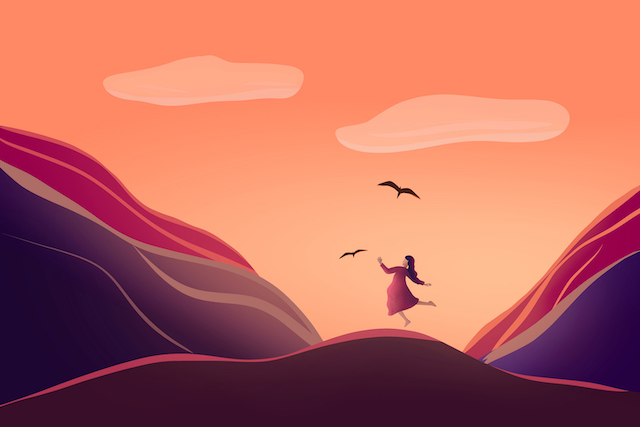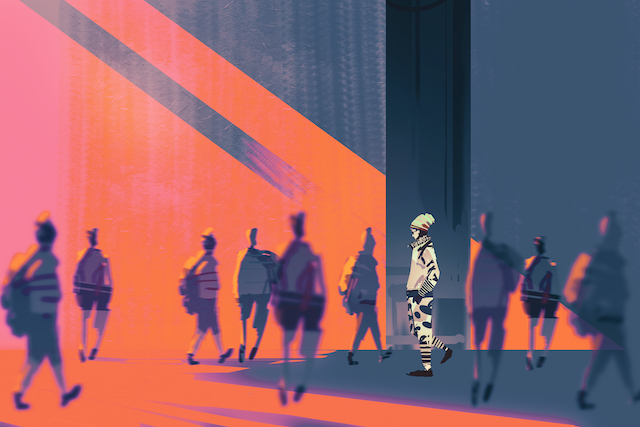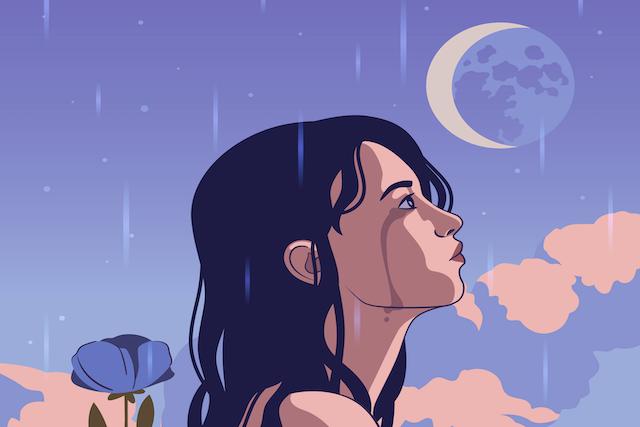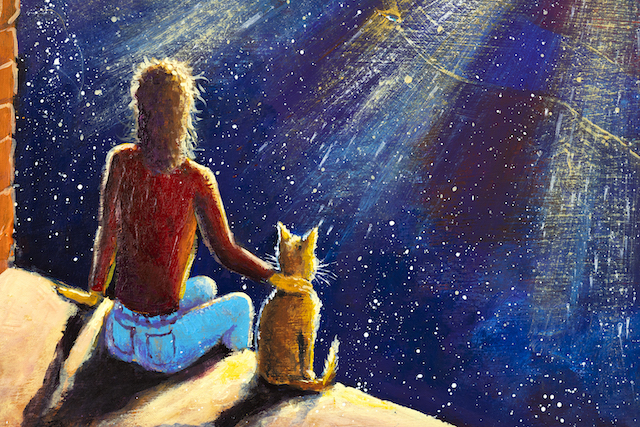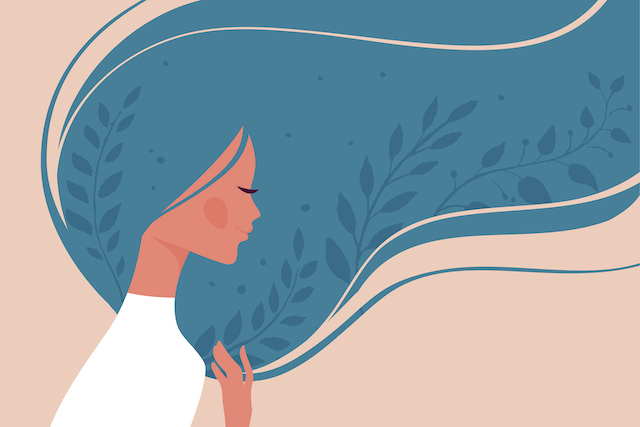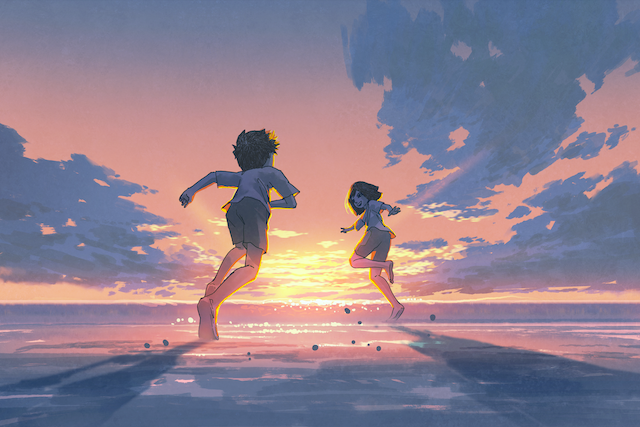
“Don’t let this silly world trick you into starving your soul for material things. Cause someday you’re gonna be sitting out under the sun and realize how little you actually need to be truly happy.” ~Brooke Hampton
It was early morning. The birds were chirping, the street sweepers were methodically clearing debris off the sidewalk, and the coffee vendor was chattily filling his customers’ cups with fragrant java from the dispenser precariously balanced on the back of his bicycle. There I was, taking a pleasant and serene walk while on my recent visit to India.
As I took a turn into a small sideroad, I noticed two little girls running around and playing. At first, I didn’t take much notice. But then something grabbed my attention.
The gleeful duo was scampering around chasing each other, squealing with delight, clapping their hands, laughing hard, and just plain enjoying each other’s company. Again, nothing extraordinary. But something was drawing my attention to them, and then I saw it.
They were pretty much absent of what we would define as typical material needs.
No toys to play with. No playground to run around in. Old, worn-out clothing. Disheveled hair. Not even any footwear while running around the street.
My first thought was, how could they be so happy? Do they not feel despondent or envious of other kids that have more? Do they not feel worried about their futures?
But none of that really seemed to matter. They were living life in the moment, completely and joyfully absorbed into their natural sense of play.
My next rationalization was “they are just kids,” ignorant to the social and economic structures and norms. Oblivious to how the world really works.
But then, I figured, we see this same level of psychic energy and consciousness in adults too.
A climber could spend hours on a rock face and be completely absorbed with the challenge, the interaction between her fingers and the next rock outcrop, the changing weather patterns, and the ultimate goal—the top of the cliff.
A violinist in an orchestra becomes the violin, completely engrossed with the activity of playing his part, but also being in absolute synchrony with the broader group.
A painter could spend hours honing her painting, unaware of her immediate surroundings.
So does this experience only come to fruition when the skills required are more refined or complex? Not really.
Take a factory assembly line, where two workers are next to each other doing the same repetitive task over and over again. One may be carrying out their task in a mechanical fashion, while the other may be immersed in their curiosity, with a sense of perseverance to continually improve their skills and quality of work.
Imagine two individuals standing next to each other at an art museum staring at a Rodin statue. One may be passing through and merely throwing a glance at the marble figurine. The other may be swept into a different realm, admiring the intricate contours and appreciating the level of difficulty and complexity of the art in front of her.
How does this happen? Why are the experiences for the exact same activity so different for two individuals?
I truly believe this is due to what I call the power of play.
And the beauty and simplicity of this is that it can work with anyone, in any activity, in any situation, or in any environment.
There are a few criteria we need to keep in mind to make an activity an optimal experience. Ask yourself these questions before you start any activity.
Can I actually do it?
The activity has to be achievable. In other words, you have the needed skill to complete it, or the ability and resolve to learn the skill.
Can I focus on it with my everything?
The activity should require your full concentration, and that’s usually possible when we are applying effort toward a goal and getting immediate feedback as to whether it is working or not. If not, we can find our concentration starting to wane.
Does it move me into a different mental axis?
This concentration and effort take us away from our day-to-day reality, and any negative connotations that may be encumbered with it—away from the worry, stress, anxiety, or fear that we may experience in our daily lives.
Will I “be present” in my being?
Our level of self-awareness is acutely sharpened, taking in all the ebbs and flows of our thoughts, feelings, and energy levels. This allows us to feel in control of our consciousness, our emotions, our life flow.
Can I alter time?
And finally, it changes the perception of time. Sometimes, say when playing an exciting game of tennis, time can swiftly fly by. Sometimes, like when we are excitedly learning some new dance steps, time and motion can slow down, and we appreciate these micro-moments.
When we leap off the diving board and plunge into this state of play, we experience a great sense of enjoyment—a feeling that the psychic energy we have consumed was worth it and has resulted in a great outcome, one that can be savored for a long time to come.
And that is how we can have more with less.
If we can make small, discrete changes to meet these criteria, it can make a transformational difference in whether we immerse ourselves into the experience or are “just in it for the ride.”
We can make every day, every activity, every experience, fulfilling and nourishing to our soul by simply being more present with what we’re doing and bringing more enjoyment to what we do. Pause and think about how you can make any activity more enlightening, and you will see it lightening your life as the heaviness melts away.
Just like the two little girls that were completely involved and enjoying the experience of play together, savoring life together.
They didn’t need anything more.
PS: The next day I bought those little kiddos some footwear, and the way their faces lit up was such a joy to see!
![]()
About Jayashree Chenglath
Jayashree Chenglath believes that play is the antidote to burnout. She is the founder of Simplify Being, where she helps her clients simplify every aspect of life so that there is more being and less absent-minded doing. After learning from her own painful experience with burnout, she is now a board-certified health and wellness coach, helping individuals and corporations achieve their wellness goals— one tiny step at a time.
Get in the conversation! Click here to leave a comment on the site.
The post How You Can Have More with Less: The Magic and Joy of Being Present appeared first on Tiny Buddha.
from Tiny Buddha https://ift.tt/1CXGnOE


